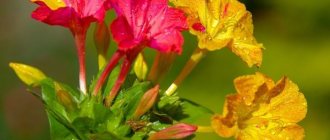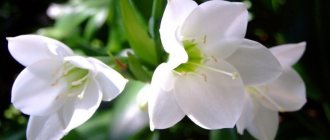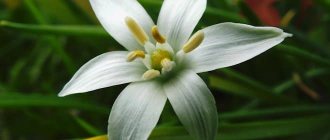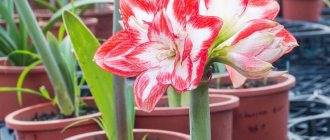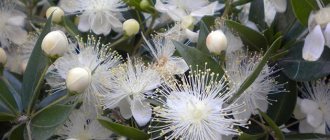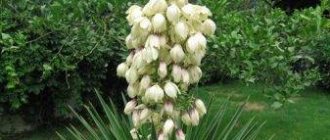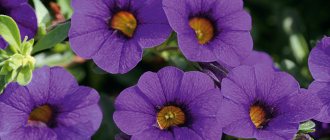Increasingly, flower growers are coming to the attention of representatives of lush tropical flora that are unusual for growing in home culture.
Many of them are distinguished by their fastidious nature and difficult requirements for growing conditions, which does not prevent their relocation from greenhouses and winter gardens to the window sills of city apartments.
One of the most spectacular tropical sissies can be called Medinilla, striking with its rich greenery and magnificent flowering.
Description of Medinilla
The Medinilla genus includes about four hundred evergreen tree and shrub forms and several species of herbaceous vines.
These are plants from the tropical forests of the Philippine Islands, also found in Australia, in the east of the African continent and in the southern regions of the Asian region. Interesting! The name of this flower was fixed in the second decade of the 19th century - the plant received its name in honor of the governor of the Mariana Islands, José de Medinilla y Pineda.
In their natural habitat, some species of Medinilla grow up to 3 m, in greenhouses these plants reach 2 m, and in home culture their height does not exceed 0.3 - 1.5 m.
The value of Medinilla lies in the fact that it retains its decorative appearance regardless of flowering . Strong stems of a greenish-brown tone bear voluminous whorled or opposite leaves of a dense, thickened, leathery structure.
Whole leaves of an elongated oval shape (within 30 cm) are distinguished by their juicy dark green color. Their lighter veining and slight concavity create the effect of a wavy graphic relief.
But the main thing, because of which flower growers are ready to endure all the hardships of growing Medinilla, is its grandiose inflorescences. In spring, large pyramidal buds of pink, salmon or lilac shades form in the leaf axils on drooping, elongated pedicels.
Each inflorescence consists of several tiers: under 2 - 3 rows of large wings of bracts with bright stripes, numerous rows of small, tubular or bell-shaped flowers with fluffy anthers on long stamens densely fall.
Botanical description with photo
The Medinilla genus belongs to the Melamastaceae family. Its homeland is the Pacific islands, as well as the Asian and African tropics. It can look like a vine, shrub or tree, has large leaves and inflorescences, but usually does not exceed 2 meters in height or length (for vines). It has an epiphytic or semi-epiphytic (starting on a tree and ending on the ground) type of development, therefore it can grow both on the ground and on trees or other plants.
The leaves are a noble muted gray-green color with a wavy edge and sparse light-contrasting veins. In some varieties, the leaf blade is serrated, but more often it is solid; petioles are also not present in all varieties.
Popular types of plants grown at home
Of the wide variety of Medinilla species, only a few varieties that stand out for their decorative properties have taken root in home culture.
Medinilla splendid (magnifica)
The main representative of the genus, Medinilla magnifica , was brought to Great Britain by John Veitch at the beginning of the 19th century and instantly won the hearts of European gardeners thanks to its rich greenery and exquisite flowering.
Now this is the most common species - almost 90% of grown plants of the genus belong to it.
The plant is formed in the form of a bush up to 1.5 m high with straight, strong stems.
Luxurious oval leaves (up to 35 cm) with a leathery surface are painted in rich green tones. Each leaf is decorated with a pattern of light veins.
Curious! The beauty and structure of the inflorescences of Medinilla magnificent gave it another name - grape rose.
Elegant racemose inflorescences (up to 50 cm) of pale pink, deep pink or white tones hang from the axils of the leaves. The voluminous greenish-pink (a distinctive feature of the species) bracts fall off soon after the inflorescence opens. Under them, many small flowers with bell-shaped corollas bloom, collected in a lush waterfall.
Flowers have an exquisite aroma , the concentration of which varies throughout the day. Flowering continues for quite a long time - from April to July.
Medinilla splendid is recognized by flower growers all over the world as one of the most beautiful flowering plants. This species includes more than a dozen decorative varieties - the most spectacular of them are shown in the photo:
- Jadore Dolce Vita - the plant is distinguished by the bright pink color of the flowers and narrow bracts, which are dispersed in large numbers along the inflorescence raceme
- Trezor - a characteristic feature of the plant is the absence of bracts, less fullness of the inflorescence and the original color of the flowers: white corollas on bluish-lilac pedicels
- Bello - the plant is characterized by bright red inflorescences of shorter length
Medinilla javanica
It has an advantage over Medinilla splendor, as it is less picky and easily adapts to rooms with normal humidity . This circumstance puts Medinilla Yawanika in second place in terms of interest shown in her.
The plants are small in size and decorated with ovoid, medium-sized leaves of a rich green color. The inflorescences are most often a bright purple-lilac hue. The disadvantage is the lack of decorative bracts, which reduces the decorativeness of the inflorescences.
Medinilla veinata
It is not often found in home culture, as it does not have magnificent inflorescences .
A medium-sized flower with thin shoots, pubescent along the entire length.
The decorative appearance of the plant is given by the original elongated oval leaves (no more than 20 cm), pointed at the tip. On the dark background of the leaf, a protruding venation pattern is clearly visible.
The small tubular flowers of M. veinata are collected in small umbels of inflorescences. The color of the buds has white, flesh-colored or pinkish-yellow shades.
Medinilla cuminga
A spreading plant of small size. It is distinguished by large (up to 30 cm) leaves of an oval configuration with a shiny, slightly concave surface and obvious venation.
Flowering occurs in spring. The inflorescences are large, erect, without bracts. The flowers are medium-sized (up to 5 cm) and pink.
Flower location and lighting
It is known that medinilla feels equally bad both with a lack of sunlight and with prolonged exposure to sunlight. But the plant simply needs oblique rays of the sun in the mornings and evenings. Based on this, you will select a suitable place for the flower on the south side of the apartment, slightly in the back of the room. If you place it on or near a windowsill, be sure to shade the plant with light curtains or blinds during the midday. Otherwise, irradiated with ultraviolet rays, the plant will get sick or even die.
Windows in eastern and western directions are also suitable for medinilla, but in the autumn-winter periods it will require illumination with artificial lighting lamps or a phytolamp. The plant needs at least 12 hours of daylight. It should be remembered that the distance from the lamp to the crown should not be closer than 60 cm, otherwise you will burn the delicate leaves and inflorescences. Northern windows are not suitable for a flower, because even in summer there will not be enough sunlight for it.
The pot of medinilla should always be in the place you choose. It is not advisable to rearrange it, and during flowering it is simply unacceptable. When choosing its place of residence, take into account the fact that the plant does not tolerate drafts and hot air near heating devices in winter.
Florarium
Some gardeners grow medinilla in florariums. A florarium is a composition of living plants grown in a glass terrarium. It could be an aquarium, a glass, a jar. In addition to plants, there may be various decorative elements: beautiful pebbles, pieces of driftwood, shells. In such a home greenhouse, medinilla will feel great, provided it is a compact variety or is still very young. For example, a dwarf species, Medinilla sedumifolia, grows well in a florarium, where a soft microclimate with high humidity is created for it.
You can read about medinilla sedumifolia, as well as many other types and varieties of medinilla here .
A home florarium is not suitable for tall and spreading specimens. You will need a large transparent enclosure (showcase or window) with special equipment for watering, lighting, ventilation and bottom heating. Such a structure is not cheap, so it is rare.
Medinilla: care
The tropical plant is quite capricious and places increased demands on living conditions. But if you follow the growing regimes, care at home will not cause any particular difficulties.
This video gives advice on which plant should be purchased so that it develops successfully and blooms richly:
Placement and lighting
One of the important requirements of a tropical plant is the creation of optimal lighting : both a lack of light and prolonged exposure to direct rays of the sun are harmful to it. Oblique morning or evening rays are especially useful for the plant.
Important! The medinilla should always be in the same place. Rearranging the plant is unacceptable, especially during the flowering period!
It would be ideal to place the plant on the south side of the house in the back of the room - when installing a pot on a window, shading is required during the midday.
Northern and western windows are dangerous due to insufficient light, which can lead to the dropping of buds, wilting of leaves and death of the flower. With this arrangement, lighting is required.
Temperature
To create comfortable conditions for the plant during the active growing season, it is necessary to maintain the temperature at a level not higher than 24°C . As the rest period approaches, the indicators are gradually reduced and brought to 17°C.
When determining a place for a plant, you should pay attention to the proximity of central heating systems - this can create temperature changes.
Attention! It is imperative to protect the plant from drafts, which threaten it with loss of decorativeness.
On north-facing windows in winter, the root system may cool down, so it is necessary to provide a warm tray.
Watering and air humidity
Medinilla is a moisture-loving plant ; even slight drying of the soil leads to the dropping of flowers, drying of leaves at the tips and their falling off.
During the active period, the plant needs frequent and abundant watering - daily or once every two days, which depends on the air temperature. The water needs to be settled and heated to room temperature . To prevent stagnation of water in the pot, care should be taken to create a drainage layer in advance.
Watering in autumn and winter is significantly reduced - up to 3 or 2 times a week. For plants with a dormant period, it is necessary to follow the rule: the lower the temperature, the less watering.
The main requirement of Medinilla is high air humidity (approximately 70 - 80%) all year round . To create tropics you can use:
- Water containers or humidifiers;
- The “double bottom” principle - the space between the pot and flowerpot is filled with wet moss;
- Additional tray with water and large pebbles.
Advice! When creating high humidity, regular ventilation is required to prevent fungal diseases.
Feeding
The plant reacts positively to the application of various fertilizers, increasing the number of buds and improving its decorative effect.
In the summer, you can use universal fertilizers in half the dose of the quantities indicated on the package . Carry out the procedure 2 times a month. It is possible to alternate with organic matter, subject to the feeding regime.
When the buds are forming, they switch to fertilizing for flowering plants and change the regime, increasing the frequency of procedures to 3 times a month.
Trimming
After flowering is completed, all faded inflorescences are cut off and the shape of the bush is adjusted, shortening particularly long shoots. This gives the plant strength and promotes branching.
Small vines of the genus cultivated at home need pruning - this is especially true for M. waterhouse.
Cut branches can be used for cuttings.
Planting and replanting: pot, soil, drainage
Young medinillas, so that they develop faster, are replanted every spring, and sometimes additionally in the summer, large plants a year or less often, after flowering. During transplantation, you can do sanitary pruning and remove elongated shoots. Large bushes are difficult to transplant, so you can limit yourself to replacing the top layer of soil (about 5 cm).
Young medinillas grow so quickly that they are sometimes replanted twice a year.
Medinilla has a massive upper part, but the underground - root system - is not very developed, like all epiphytes. The roots are located near the surface, so there is no point in choosing a deep pot. It is better to take a wide container. And so that the flower brushes hang freely, place it in a high flowerpot or on a stand. The material of the pot is not so important; both plastic and ceramics will do. Hanging baskets, in which drooping medinilla inflorescences look especially picturesque, will be lighter if made of plastic. But the container that you plan to place on a high stand will be more organically made of ceramics. A magnificent medinilla should have a pot to match it.
Everything should be beautiful in medinilla, both flowers and flower pots
In its natural environment, medinilla is content with rather meager soil, but it is always very loose. It consists of the remains of other plants. At home, you need to maintain lightness and porosity, but add a little nutrition. Medinilla can be planted in prepared soil for epiphytic plants or a mixture for orchids. Other soil substrate options:
- turf and leaf soil 2 shares each, coarse sand and peat 1 each, add coconut substrate for looseness;
- leaf and turf soil equally, half - sand, peat and humus, you can add fiber and coconut chips or pine bark;
The soil for medinilla needs to have such a structure that after watering in a warm room (24–26°C) it dries out in two days, no more. If the soil does not dry out for 5 days or longer, it may turn sour. Then the roots will begin to rot. The drainage layer also saves you from this problem. Before planting, stock up on broken red bricks, expanded clay, large vermiculite or perlite. On the eve of planting or transplanting, steam or calcine the soil mixture and drainage.
Transplant instructions
- Place a drainage layer at the bottom of the pot; its height depends on the size of the container.
- Place some soil on top of the drainage and moisten it.
- Remove the plant from the old pot without destroying the soil with its roots.
- Inspect the roots; if there are rotten ones, carefully remove them.
- Move the plant to a new pot.
- Gradually fill the earthen ball with fresh soil, slightly compacting the void between it and the wall of the pot. Medinilla does not like dense soil.
- Water the plant a little, spray it and place it in a permanent place suitable for the conditions.
Changing the pot does not bother Medinilla, but it is better to support her with feeding. Add a rooting preparation (Kornevin, Zircon, Ecogel) to the irrigation water once a week. Spray the plant with a very fine sprayer with Epin solution (2-3 drops per glass of water).
How to choose medinilla?
Buying medinilla is a very responsible matter. This flower is quite expensive. Therefore, if you fail, you will feel sorry for wasted money. By the way, the best time to buy a plant is summer or early autumn. Then the adaptation of medinilla is less painful.
When choosing a plant, carefully examine the leaves and stems. If you see traces of pests or any stains, refuse to purchase. Dark spotting on the stems is especially dangerous. Most likely it is a fungal disease. This plant cannot be treated. It is not recommended to buy discounted weak medinilla; these capricious plants do not restore health well.
When buying medinilla, be careful and make sure the plant is healthy
After the store, immediately find a permanent place for the flower. Let him get used to his new home for 2-3 weeks. And then transship the plant. It is better to remove the plastic pot from the roots by cutting it with a hot knife, so the earthen lump will be preserved entirely. There is no need to compact fresh soil. When the soil settles after watering, add more.
It often happens that tender medinillas die a week or two after purchase. The change in conditions of detention has such a sad effect. To prevent the purchased plant from dying, do not buy recently brought flowers. Opt for specimens that have been in the store for about a month and remain vigorous.
Medinilla finds it difficult to adapt to new conditions; frequent changes can cause her to wither away
Plant support
Medinillas are often grown in an ampelous form. In hanging pots or baskets, the plant will not need support; the shoots and brushes with flowers hang freely.
It is better to install the support in the pot in advance, while the plant still holds its shape.
But, if a medinilla bush grows in a pot on a stand, over time it may “fall apart”. The stems, weighed down by a massive crown, begin to bend. Prevent the problem at the very beginning by placing a cone-shaped support in the pot. This can be a design from a store or made independently. For example, place bamboo sticks around the circumference of the pot and connect them with flexible wire or twine. The main thing is not to allow the shoots to deviate significantly from the vertical.
Transplanting a plant
The transplantation procedure is carried out depending on the age of the plant: young bushes are advised to replace the pot annually, adult flowers can be disturbed after 2 - 3 years (while carefully changing the top layer of soil every year).
You can choose a shallow but wide pot, since Medinilla has fibrous roots that grow well in breadth.
A high drainage layer is required at the bottom .
The soil required is light, with good air exchange and sufficiently nutritious.
How to care for a finicky flower?
Medinilla loves to be looked after. And sometimes she behaves like a capricious girl who doesn’t know what she wants. But there are some rules for communicating with this picky person. Maintain the watering regime and moisten the air more than the soil, do not overfeed, and do not change the location unless absolutely necessary.
Caring for medinilla is not easy, but if you make friends with this fastidious plant, your room will be wonderfully transformed.
Watering and fertilizing
A large flowering plant consumes a lot of moisture. In the warm season, medinilla is watered when the soil has dried 2–4 cm from above, and with the right soil this will take 2–3 days. Complete drought at the roots will harm the flower, but overwatering is even worse. It promotes the development of putrefactive diseases. Therefore, in autumn and winter, when medinilla hibernates and does not absorb water, watering is significantly reduced. The soil should dry out more and remain in this state for 3-4 days. If you are worried that the plant is not getting enough moisture, spray it. Epiphytes are able to obtain drink through leaves.
Medinilla is very sensitive to water quality
The quality of water for medinilla is important. She will be grateful for the lukewarm drink devoid of salts. This means that the water needs to be settled or filtered and not cold. This applies not only to watering, but also to spraying the plant.
A flowering plant needs increased nutrition
During growth and flowering, medinilla will benefit from feeding. But you shouldn’t be overzealous with nutrition. Mineral complexes for flowering plants must be diluted twice as much as recommended in the instructions. Add the solution to irrigation water every 2–3 weeks. In winter, medinilla does not need nutrition.
Reproduction of Medinilla magnificent
In home culture, grape roses are quite difficult to propagate. To do this, you can try two methods: cuttings and growing from seeds. But they do not guarantee a positive result.
Propagation by cuttings
Vegetative propagation is carried out from January to May.
To do this, cut cuttings with 3 internodes and, after treatment with phytohormones, root them in sand or moss using a greenhouse.
After rooting and the beginning of development, pinch the growing point to obtain abundant branching.
Propagation by seeds
It is a little easier to germinate Medinilla from seeds at home. The main thing is to find fresh seeds, which are distributed shallowly in sandy soil and covered with film.
When heated from below, you can get shoots in a month. After germination of two leaves, picking is carried out.
Basic rules for home care
To see how beautifully medinilla blooms at home, it needs to create not just good, but ideal conditions:
| Temperature | In winter – up to + 17° C; in spring and summer + 21 - 25 ° C, higher temperatures have a bad effect on the flower; in autumn the temperature gradually decreases. |
| Air humidity | High, about 75%; place on a tray with wet pebbles and spray. |
| Lighting | Diffused bright light, shaded from direct sunlight; in winter - additional lighting. |
| Watering | The soil surface should dry out; In spring - autumn, water abundantly, in winter - moderately. |
| Priming | 1 part perlite and peat for 2 portions of deciduous soil and humus; ready-made soil mixture for epiphytic plants. |
| Feeding and fertilizer | From mid-spring to early autumn - 1 time every 14 days with liquid universal fertilizer; do not feed in winter. |
| Transfer | Young people - every year in the spring, adults - after 2.5 years. |
| Reproduction | By seeds (February - March) or semi-lignified cuttings (January - May). |
It is necessary to take into account the peculiarities of growing medinilla in order to grow a beautiful and healthy plant. It is fundamentally important to create a warm and humid atmosphere (some gardeners grow medinilla in a florarium or display case for this purpose) . From late autumn to late winter, the flower is kept at a lower temperature to allow new buds to form. In the spring, pruning is carried out. When flowering ends, the branches on which the flowers grew are pruned and watering is reduced.
Bloom
The abundance and beauty of flowering directly depends on the care of the plant during the cold season - this is when the process of formation of future buds occurs.
During this period, the plant is at relative rest; it requires lower temperatures (about 17°C), high humidity and a sufficient amount of light.
After flowering, the bush needs significant pruning for further development.
Emerging problems
Carefully! The picky Medinilla reacts painfully to any mistakes in care.
You should know the symptoms of exposure to negative factors and how to eliminate them:
- Refusal to bloom - low lighting, low humidity or lack of conditions for a dormant period;
- Darkening of leaves - frequent watering and waterlogging;
- Shredding of young leaves and curling of adult leaves – insufficient air humidity;
- Loss of leaves and flowers - draft or moving from place to place;
- Leaves dry in winter - low temperature; in summer – high temperature and dryness;
- Pale spots on the leaves are a sign of sunburn.
After finding out the cause of the problem, it is necessary to adjust the care regimens and then strictly follow them.
Watering
This moisture-loving plant should be regularly watered with soft, settled water at room temperature. Even slight drying of the soil will lead to the tips of the leaves drying out and the flowers dropping. During the formation of buds, the soil must be kept moist at all times. But do not allow a swamp; excess water from the pot should flow freely into the pan, from where it should be removed in a timely manner. During flowering, the intensity of watering is slightly reduced, and during dormancy, it is completely reduced to a minimum and watered only after the soil in the pot has dried by half. The rule here is that the lower the temperature, the less frequent the watering.
This may be interesting: Fuchsia: description of varieties with photos
Diseases and pests
Among the diseases, Medinilla is affected by gray botrytis , which appears as black spots on the leaves and stems. The plant should be separated from other flowers, the affected parts should be removed and treated with a fungicide.
The plant is dangerous from spider mites, scale insects, and aphids. Insecticides and acaricides help in the fight against them.
Luxurious Medinilla is winning more and more fans who are not afraid of the whims of the exotic beauty. Sufficient knowledge helps to foresee all the nuances and avoid many problems in care, which is the key to maintaining decorativeness and lush flowering.
Trimming
This tropical plant responds positively to sanitary and formative pruning. Thus, pruning and crown formation can be done in early spring before the start of bud formation, for example, during medinilla transplantation. The second haircut is carried out after the end of the flowering period.
- If your task is to grow a tall bush, remove only the flower stalks.
- If you want to get a spreading bush with a lush decorative crown, then shorten the stems on which there were flowers, as well as especially long branches, by half. Remove overgrown shoots or parts thereof that spoil the decorative appearance of the bush. You can trim the shoots more strongly, right down to the woody part.
Any pruning rejuvenates the medinilla, makes it branch better, and gives the bush an attractive appearance. Cut shoots can be used for propagation as cuttings.
